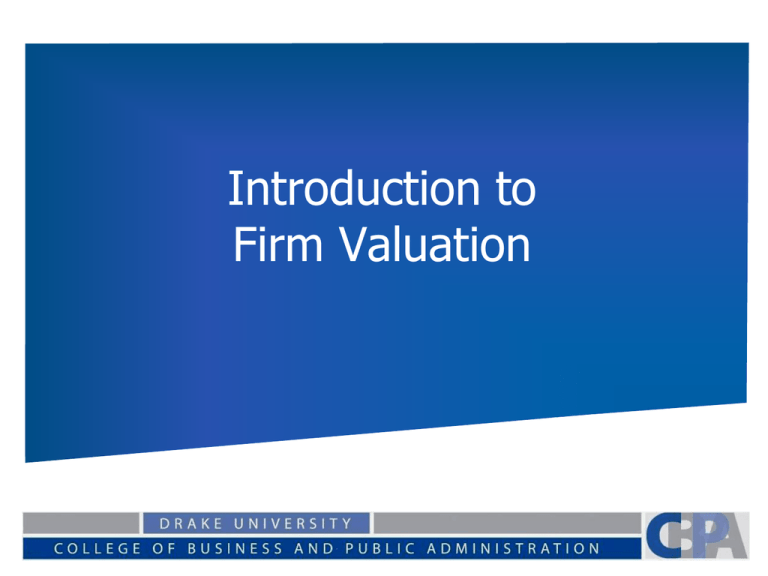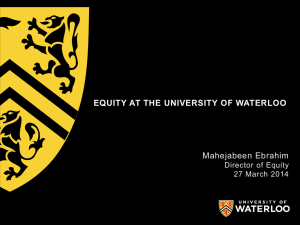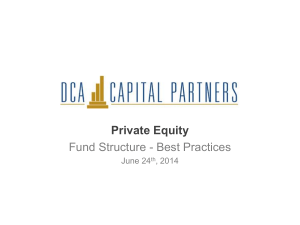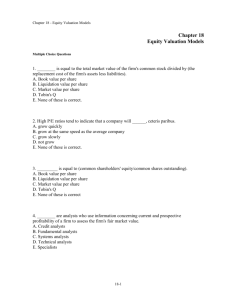Firm Valuation
advertisement

Introduction to Firm Valuation Equity vs. Firm Valuation Value of Equity: The value of the equity stake in the firm, the value of the common stock for a publicly traded firm Value of Firm: The value of all investors who have claims on the firm A General Valuation Model The basic components of the valuation are: An estimate of the future cash flow stream from owning the asset The required rate of return for each period based upon the riskiness of the asset The value is then found by discounting each cash flow by its respective discount rate and then summing the PV’s (Basically the PV of an Uneven Cash Flow Stream) The Formal Model The value of any asset should then be equal to: CFt CF1 CF2 CFn V 1 r1 (1 r2 ) 2 (1 rt ) t (1 rn ) n n V (1 r ) t 1 CFt t t Applying the general valuation formula to a firm The only questions are what to use as the future cash flows when valuing the firm and what to use as the interest rate. We are going to look at discounted cash flow three models which differ by their choice of cash flows: Dividends Free Cash Flows to the Firm Free Cash Flows to Equity Elements Common to All Models Choose Cash Flows Choose discount rate consistent with the cash flows Estimate short term growth of cash flows Estimate long term sustainable growth of cash flows and when sustainable growth starts. Cash Flows are assumed to continue forever Multi-Stage Growth Models The growth of the cash flows can be broken down into general stages. The firm may experience all three or only two of the stages. High growth Transition to Stable growth Stable growth Actually any path of growth could be assumed for the short term – the key is that at some point stable long term growth is assumed. Two and Three Stage Growth Models A two stage growth model is characterized by a period of fast growth followed by a period of stable growth. A three stage growth model is characterized by a period of fast growth followed by a transition period followed by a period of stable growth. Stable Growth Period Once a period of stable growth is reached you can approximate the terminal (horizon) value of the cash flows using the constant growth formula. CFt (1 g ) rg Generic DCF Valuation Model DISCOUNTED CASHFLOW VALUATION Expecte d Gr ow th Firm: Grow th in Operating Earnings Equity: Grow th in Net Income/EPS Cas h flow s Firm: Pre-debt cash f low Equity: After debt cash flow s Firm is in stable grow th: Grow s at constant rate f orever Terminal Value Value Firm: V alue of Firm CF 1 CF 2 CF 3 CF 4 CF 5 CF n ......... Forever Equity: Value of Equity Le ngth of Pe r iod of High Gr ow th Dis count Rate Firm:Cost of Capital Equity: Cost of Equity The Dividend Discount Model The value of a share of stock should be the PV of the dividends you will receive in the future if you own the stock. The Formal Model Allowing the CF in the general valuation model to be the expected future dividends the model becomes: E(Dt ) E(D1 ) E(D2 ) E(D ) V 2 t 1 re (1 re ) (1 re ) (1 re ) V t 1 Expected Dividend t (1 re ) t Estimating growth rates Historical Growth Rate Comparison to analysts forecasted growth Growth based upon investment policy Dividends are based upon the amount reinvested in the firm g=(retention rate)(ROE) Stable growth Stable Growth When the firm reaches stable growth the characteristics of the firm also change – this implies a change in riskiness of the firm and a change in the cost of equity. Dividend Growth Model The model can be changed to account for firms that are not currently paying a divided (high growth) but will start paying a dividend in the future. You can use a per share or aggregate measure of dividends – if there are equity options, warrants etc outstanding it is best to start with an aggregate estimate. Free Cash Flow Choices Free Cash Flow to Equity The residual cash flow left over after meeting interest and principal payments and providing for reinvestment to maintain existing assets. Free Cash Flow to the Firm The cash flow from operations that is actually available for distribution to investors (stockholders, bondholders and preferred stockholders) Free Cash Flow to Equity Net Income +Depreciation -Capital Expenditure -Changes in Net Working Capital -Principal Repayments +New Debt Issues Free Cash Flow to Equity The Formal Model Again The value of equity should be equal to: V (1 r ) t 1 FCFE t e t Value of Equity After forecasting the free cash flows it is then possible to find the value of operations for the firm. valueof Vop equity (1 r ) t 1 FCFE t t e Notice, this depends upon a forecast of future free cash flow which much like dividends are not certain. Estimating Inputs The length of high growth period and rate of return is the same as for the dividend growth model E(growth) = (Equity Reinvestment Rate)(ROE) Similarly the growth rate in the stable period should be based on stable growth Equity Reinvest = Stable Growth Rate Stable Period ROE Dividends v FCFE If Aggregate Dividends = FCFE then they produce the same value for the value of equity. IF FCFE > Dividends and the $ are reinvested in projects with NPV =0 (fairly priced assets) then the values are close. The $ are invested in low return projects FCFE provides higher value of equity. If FCFE does not equal Dividends What does the difference tell us? Which model is appropriate? Free Cash Flow to the Firm Net Operating Profit After Taxes + depreciation -Gross Capital Expenditure -Change in net operating working capital Free Cash Flow NOPAT NOPAT = EBIT(1-Tax Rate) NOPAT is the amount of profit a firm would earn if it had no debt and held no financial assets. FCF 1. 2. 3. 4. 5. Five good uses of FCF Pay interest to debtholders (cost to firm is after tax interest expense) Repay debt Pay dividend to shareholders Repurchase stock from shareholders Buy marketable securities or other nonoperating assets. The Formal Model Again Using Free Cash Flow to the firm, the value of operations should be equal to: V (1 WACC ) t 1 FCFFt t Value of Operations After forecasting the free cash flows it is then possible to find the value of operations for the firm. value of FCFt Vop t operations t 1 (1 WACC) Notice, this depends upon a forecast of future free cash flow which much like dividends are not certain. Estimating Inputs Expected growth during high growth period g = (Reinvestment Rate)(ROC) EBIT(1 t ) ROC (Book Value Debt Book Value Equity) Remember that the assumption about the Cost of capital will change as the firm grows Terminal Value Based on assumptions concerning long run growth in economy Firm Value to Equity value You can take the value of the firm and subtract the amount of debt to get to the value of equity. (use the same debt classifications you used for cost of debt) The value of equity obtained form the FCFE and FCFF valuations should be the same if you are consistent with your assumptions about financial leverage. Other things impacting Value Liabilities on lawsuits Unfunded Pensions and Health Care Obligations Deferred Taxes Firm Characteristics as Growth Changes Variable High Growth Firms Stable Growth Firms tend to tend to Risk be above-average risk be average risk Dividend pay little or no dividends pay high dividends Net Cap Ex have high net cap ex have low net cap ex ROC earn high ROC earn ROC (excess return) closer to WACC Leverage have little or no debt higher leverage Equity Valuation to per share An estimate of the value per share can be found by dividing the value of equity by the number of outstanding shares. The value of outstanding options must also addressed Value Enhancement Changes in any of the four key inputs will impact value in all models. Increases in cash flow Changes in growth rates Change in length of growth period Reduction in cost of capital. Relative Valuation You can also value the firm by looking at multiples of similar firms and benchmarking Make sure to standardize ratios that you use across firms









